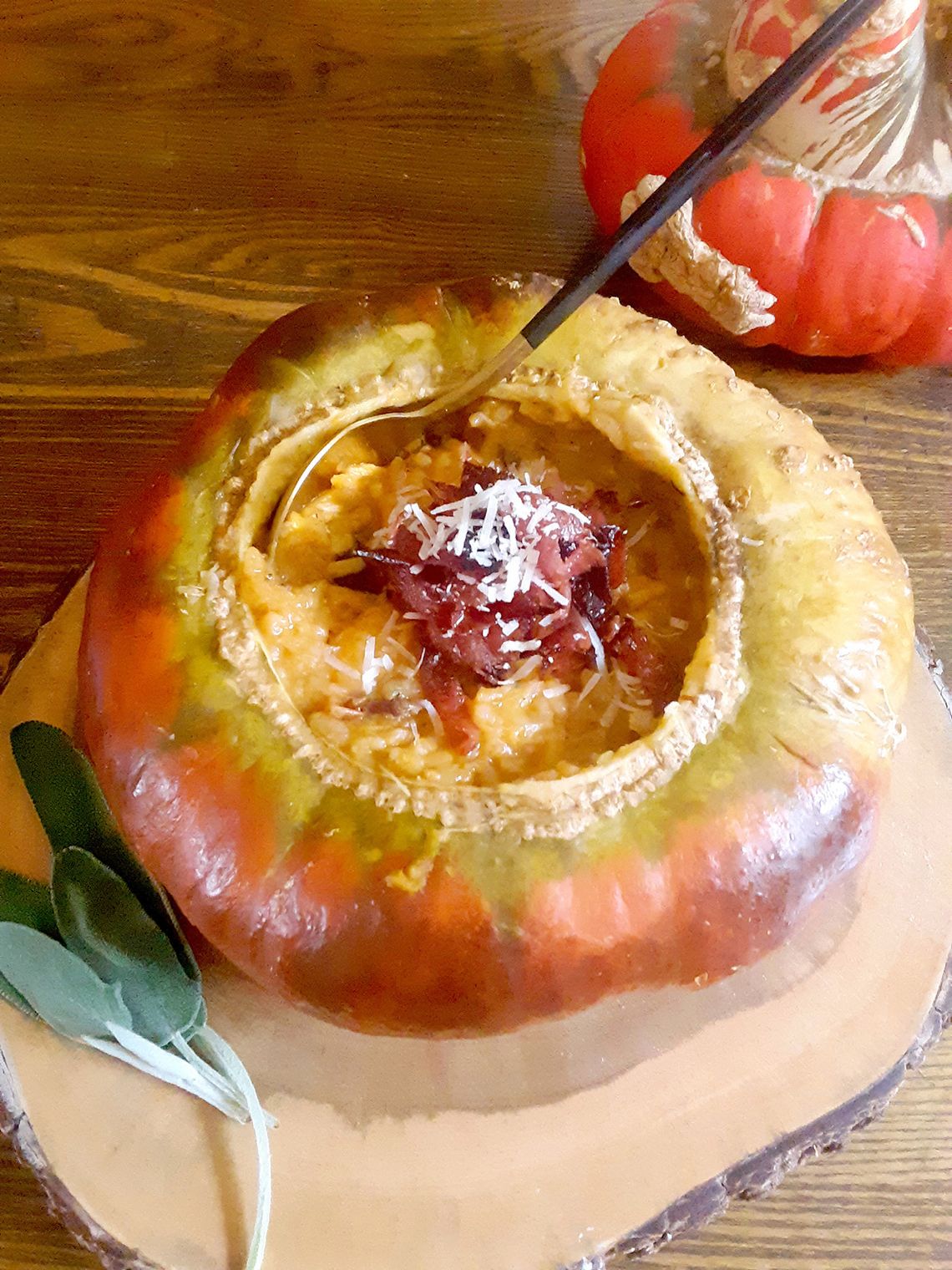Turban Squash Risotto with Crispy Salami and Sage
Recently, while in the Babbitt Zup’s, I noticed a colorful squash I had never seen before: turban squash.
Christine, the produce manager, does a great job ordering unique produce, and I always like experimenting with new varieties. I asked her about turban squash, and she said they are very sweet but hard to cut. The squash has a round outline near the top that I felt would make a perfect serving bowl. So, I took two home and tried to cut one open with my sharpest knife.
Christine was right, they are very hard. So, I took my knife and lightly hacked up the three nubs on top of the squash. That made a slit where I could insert a knife to form vent holes. Then, I baked the squash until it was tender enough to carve out a bowl, and used some of the flesh to make a risotto.
Turban squash has a lot of flesh, so there is plenty left over for another dish, or in case you want to double the risotto. Since risotto requires close attention while cooking, I recommend making this for smaller gatherings when you have most of the other dishes already prepared. You can also bake the squash a day or two ahead. The squash bowl can be kept in the fridge, covered in plastic wrap. Rewarm the bowl in the oven before serving.
Turban Squash
Risotto with Crispy Salami and Sage
Ingredients:
1 turban squash
1/4 cup light olive oil, divided
2 ounces thinly sliced salami, cut into 1/4 inch strips
5 fresh sage leaves
1 cup Arborio rice
2 cloves of grated fresh garlic
1 teaspoon grated fresh ginger
2 tablespoons red curry paste
1/2 cup white wine
1 1/2 cups reserved mashed squash
2 tablespoons maple syrup
3-4 cups hot chicken stock
1/3 cup grated Parmigiano Reggiano cheese, plus extra for serving
Salt and coarse-ground black pepper to taste
Instructions:
Preheat the oven to 400 degrees F. Wash the squash and dry well. Place it on a cutting board. Using a sharp knife, give each of the top 3 nubs a whack (not too hard). Once there is a slit in each nub, insert the knife until it reaches the center of the squash. Place the squash on a sheet pan and bake for 1 hour, rotating halfway through baking time. The exterior of the squash will still be pretty hard. Cool the squash until lukewarm, then use a sharp knife to cut out the center cap. Scoop out the seeds and discard or save for roasting. Scoop the flesh into a bowl and mash well. Measure out 1 1/2 cups for the risotto, then reserve the rest for another use. In a medium or large saucepan, heat 2 tablespoons of oil over medium heat. Fry the salami in batches until crisp. Drain on a paper towel-lined plate. Once the salami is finished, add the sage leaves and fry until crisp. Add to the plate with the salami. Drain the oil into a small bowl and reserve. Wipe out the pan. Add the remaining 2 tablespoons of oil to the pan and place it back over medium heat. Stir in the rice. Cook until the rice is starting to turn translucent around the edges. Stir in the ginger, garlic, and curry paste. Cook for 1 minute, stirring constantly. Add the wine and cook until the pan is almost dry. Stir in the squash and maple syrup, then add about 1/2 cup of the stock. Continue cooking until the mixture is thick and creamy, stirring constantly. Adjust the heat if necessary. Continue stirring in 1/2 cup of stock at a time, until you reach a thick and creamy texture before adding more. Risotto is meant to be somewhat firm when finished. Once you are happy with the doneness of the rice, remove from the heat and stir in the cheese and reserved salami-sage oil. Season with salt and pepper. Crumble in the crispy sage. Set aside a small handful of the salami. Stir the rest into the risotto. Add the risotto to the squash bowl. Garnish with reserved crispy salami and an extra sprinkling of cheese.
Yield: 6 servings.
Notes:
If you don’t want to use wine, add a splash of white wine vinegar to a measuring cup. Fill to the 1/2 cup line with water. This will give you a similar acidity level to wine. To the leftover squash, I recommend mixing it with brown sugar and sage browned butter. If you can’t find turban squash, acorn or butternut squash will work just as well.












